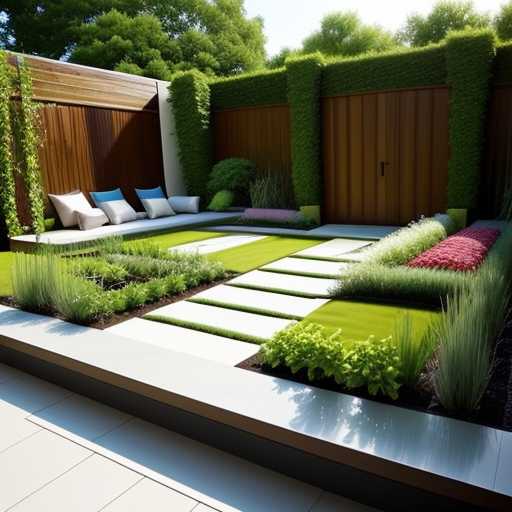5 Features of Contemporary Gardens


Sustainable design is becoming increasingly popular in contemporary gardens as people become more aware of the impact their lifestyle has on the environment. This approach focuses on creating beautiful spaces while minimizing negative environmental effects through the use of eco-friendly materials, water-wise plants, and efficient energy systems. Some key features of sustainable design include:
* The use of native plants and low-maintenance varieties to reduce water usage and promote biodiversity.
* Rainwater harvesting systems to collect and reuse rainwater for irrigation.
* Solar panels or other renewable energy sources to power garden lighting and other amenities.
* Composting systems to turn organic waste into nutrient-rich soil amendments.
* Natural pest control methods such as companion planting and the use of beneficial insects.
* Eco-friendly materials such as recycled plastic, bamboo, and natural stone in construction and landscaping.
By incorporating these features into their designs, contemporary gardeners can create beautiful outdoor spaces that are both visually appealing and environmentally responsible.

In contemporary gardens, technology plays a significant role in enhancing the overall experience. From smart irrigation systems to automated lighting, technology has made gardening easier, more efficient, and even more enjoyable. Here are some ways technology is incorporated into modern gardens:
1. Smart Irrigation Systems: These systems use sensors and weather data to determine when and how much water to allocate to plants. This not only saves water but also prevents overwatering, which can damage plants.
2. Automated Lighting: LED lights can be programmed to mimic natural sunlight patterns, providing the perfect environment for plant growth. They can also be set to turn on and off at specific times, creating a magical ambiance at night.
3. App-controlled Gardening: With the help of mobile apps, gardeners can remotely monitor their plants, receive alerts for watering and fertilizing needs, and even access expert advice.
4. Wireless Weather Stations: These stations provide real-time weather data, helping gardeners make informed decisions about when to water, fertilize, or take other actions based on current conditions.
5. Drone Agriculture: Drones equipped with high-resolution cameras and sensors can inspect plants for pests and diseases, assess crop health, and even identify areas that need additional nutrients.
By incorporating technology into their gardens, homeowners can create personalized, sustainable spaces that cater to their unique needs and preferences while minimizing environmental impact.

Contemporary gardens are all about blurring the lines between indoor and outdoor spaces. This trend is becoming increasingly popular as people seek to create more natural and organic environments in their homes. By incorporating elements such as large windows, sliding glass doors, and retractable roofs, contemporary garden designers are able to seamlessly integrate the outdoors into the living space. This creates a sense of continuity and flow between the two areas, making it easy to move from one to the other without feeling like you have left your home. Additionally, this feature allows for increased access to natural light and fresh air, which can improve the overall health and wellbeing of those who spend time in the space.

In contemporary gardens, functionality is a key feature that cannot be overlooked. Homeowners and garden designers alike are looking for ways to create outdoor spaces that not only look beautiful, but also serve practical purposes. Here are some ways that modern gardens are focusing on functionality:
1. Multi-Purpose Spaces: Modern gardens often incorporate multi-purpose spaces that can be used for a variety of activities, such as dining, entertaining, or relaxation. These spaces may include built-in seating areas, outdoor kitchens, or fire pits.
2. Water Features: Water features such as fountains, pools, and waterfalls are becoming increasingly popular in contemporary gardens. Not only do they add beauty and tranquility to the space, but they also serve a functional purpose by providing a source of clean drinking water or helping to cool the air on hot days.
3. Vertical Gardens: Vertical gardens, also known as living walls or green facades, are another way that contemporary gardens are focusing on functionality. These structures allow homeowners to grow plants and vegetables in a compact space, while also providing insulation and reducing noise pollution.
4. Solar Panels: Solar panels are being integrated into contemporary gardens to provide renewable energy for homes and businesses. By harnessing the power of the sun, these panels can help reduce dependence on fossil fuels and lower energy bills.
5. Smart Gardening Technologies: With the rise of smart technology, there are now a variety of tools and devices available to help homeowners manage their gardens more efficiently. From automated irrigation systems to mobile apps that track soil moisture levels, these technologies make it easier than ever to maintain a healthy garden.

In contemporary gardens, designers are pushing the boundaries of traditional materials and incorporating unconventional elements into their designs. From recycled plastic lumber to repurposed metal, these innovative materials offer unique benefits that enhance the overall aesthetic and functionality of the garden. Not only do they provide a sustainable alternative to traditional materials, but they also add a layer of creativity and interest to the space. As a result, contemporary gardens are not only beautiful, but also environmentally conscious and functional.